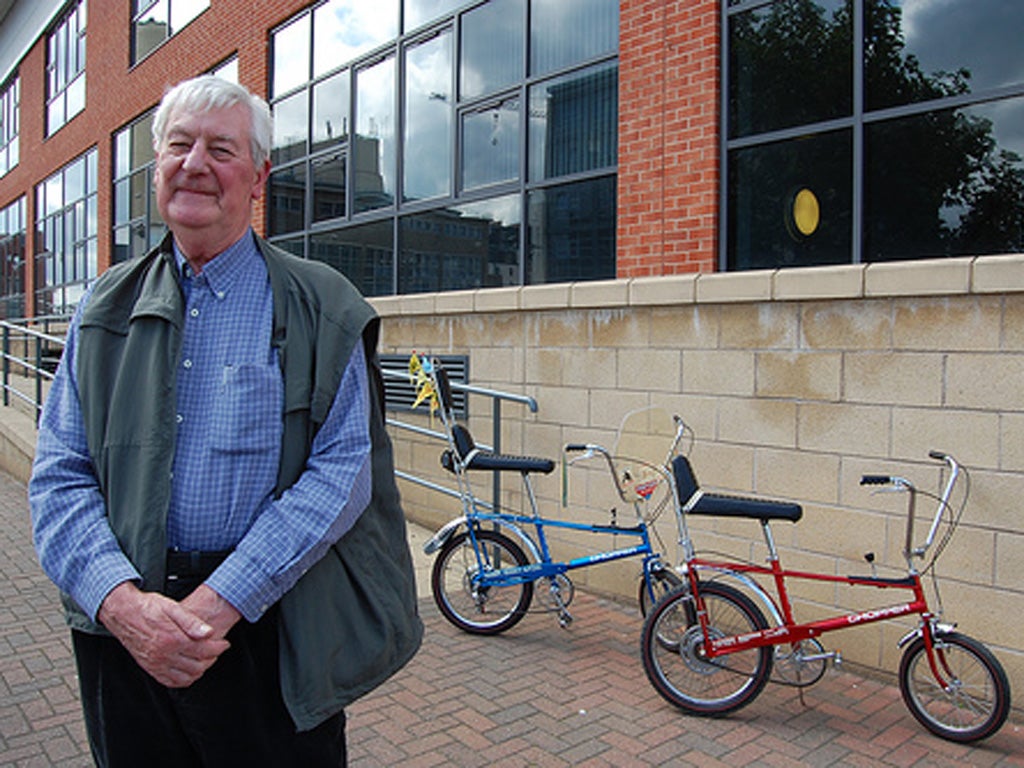Alan Oakley: Designer whose Raleigh Chopper bike was a defining image of the 1970s
Oakley had an envelope, his wife said, 'and he just drew this bike on the back of it – and that was it'

It is hardly possible to avoid the term "icon" when referring to the creation of the cycle designer Alan Oakley, for he produced one of the objects which helped define 1970s Britain: the Raleigh Chopper bicycle. It mattered not that some considered the Chopper ungainly and absurd, or that others worried it might be unsafe because it seemed difficult to steer, with a large saddle which sometimes encouraged two kids to clamber aboard. Its shape, at once unorthodox and irresistible, and the cachet that came with it, made it the must-have equipment of its day. It conferred instant cool on its young owners, generating envy among their peers. In effect it was the Apple iPad of its time.
Its impact came from the fact that it revolutionised the traditionally conservative world of British cycle design. It conjured up, with its outsize handlebars, the world of the Hell's Angels and the road movie Easy Rider in a form acceptable to the young and their parents. It was eye-catching, flashy, snazzy. It was a huge success for Raleigh, selling a million and a half during the 1970s despite being more expensive than standard cycles. Its devotees can still be found out there on the internet, where Choppers and their spare parts are still bought and sold.
Its invention is the stuff of British cycling legend. "Alan had been over to America looking to pick up a design for a bike," Oakley's wife Karen recalled. "While he was flying back, he had an airmail envelope and just drew this bike on the back of it and that was that – the creation of the Chopper."
While that was the high point of Alan Oakley's 40-year career as designer of bicycles for the Nottingham-based Raleigh firm, he had a hand in many other products. In the 1950s he was, for example, responsible for developing the track bikes for Raleigh's world champion track cyclist, Reg Harris. This laid the foundation for the Raleigh road team leader, Joop Zoetemelk, to win the Tour De France in 1980 in the famous red, black and yellow colour scheme conceived by Oakley.
Alan Oakley was born near Nottingham in 1927, the son of a local printer. He studied mechanical engineering, joining Raleigh as a trainee draughtsman, originally working on projects connected with the Second World War. His early interest was in aviation but he quickly made a lifelong connection with bicycles. "It's funny because Alan initially wanted to work with planes," Karen Oakley recalled, "but as soon as he became involved with bikes he knew that was for him."
Oakley will always be primarily identified with the 1970s classic which, with its strong visual appeal, developed a cult following. His inspiration came during a trip to California, where cool West Coastinnovation was far ahead of the comparatively staid Britishapproach. Some manufacturers were turning out bikes with a dash of Hell's-Angels chunkiness about them, while individuals were customising orthodox cycles.
The Chopper was appealing on so many levels: for one thing the choice of its name was inspired, as were itsexcitingly named colours, such as fizzy lemon, infra-red and ultra-violet. Even its price, higher than the average bike though not at a forbidding level, added to its allure.
Many Chopper owners were not old enough to be allowed in to watch the Easy Rider film, in which Dennis Hopper and Peter Fonda cruised the wide-open spaces of the US on Harley-Davidsons, free spirits of the thrilling new counter-culture. But images from the movie were everywhere, and posters were pinned up by the million in adolescent bedrooms.
All this combined in a phenomenon which soared beyond the bounds of mere transport to become an immensely desirable fashion and lifestyle accessory. The kid who got a Chopper got respect and envy. According to Gary Hughes, who runs the Raleigh Chopper Owners' Club: "It's the whole thing of the dragsters, the actual shape of the bike, the big wheel. The Easy Rider film – it was the next best thing to that Harley-Davidson bike that Peter Fonda used to ride."
Traces of that envy have persisted for decades. The journalist William Cook reminisced in the New Statesman in 2004: "I was never allowed a Chopper, but that didn't stop me admiring them from afar. This absurd but beautiful bicycle was the acme of childhood chic. The boys who rode Choppers wore Wrangler jeans and beetle-crushers, danced to records by Mud, Slade and Sweet, and snogged all the girls at youth club discos."
There were some early safety concerns over the stability of the high handlebars, known as "ape-hangers", and the fact that the seat could, at a pinch, precariously hold two kids. It also had a tendency to wobble at speeds, and would sometimes tip over backwards. A quickly produced Mark II version addressed such shortcomings.
In 2004 Raleigh introduced a new version of the Chopper which, however, failed to repeat the success story. Oakley attended its launch but conveyed privately that he was unhappy it was to be made in the Far East rather than in Britain. After retiring from Raleigh in 1982 he went to work for the Department of Trade and Industry as well as the Design Council and Science Research Council.
Alan Oakley, bicycle designer: born 27 Netherfield, Nottinghamshire 27April 1927; married 1954 Brenda Wilson (one daughter deceased), 1992 Karen Oakley (one son); died 18 May 2012.
Subscribe to Independent Premium to bookmark this article
Want to bookmark your favourite articles and stories to read or reference later? Start your Independent Premium subscription today.

Join our commenting forum
Join thought-provoking conversations, follow other Independent readers and see their replies
Comments